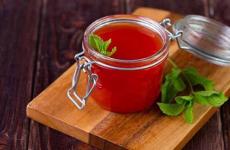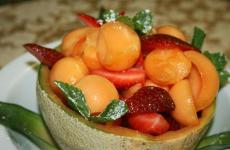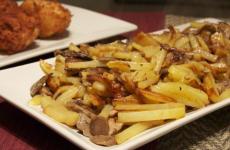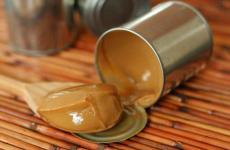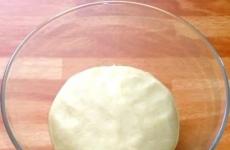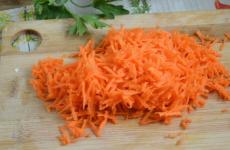Nardek (Watermelon honey). Watermelon honey nardek Honey from watermelon juice
Properties of nardek (watermelon honey)
How much does nardek (watermelon honey) cost (average price for 1 jar)?
Moscow and Moscow region.
The most fragrant watermelon honey or nardek, which is brewed from the juice of a fully ripened striped berry, is one of the many inventions of the cuisine of Central Asia, which was later adopted by the Don Cossacks. Over time, all melon growers began to prepare nardek (watermelon honey), since preserving the harvest until the new season was a guarantee of a well-fed life for a large family. And today it is brewed in Central Asia, in the south of Russia, as well as in the Lower Volga region.
A distinctive feature of nardek (watermelon honey) is that it is prepared without adding sugar. By the way, close relatives of this product are considered to be bekmes (grape honey), irchal (bekmes, but with berries), and also cue (honey made from fruits with added sugar). The word “nardek” itself is characterized by Turkish origin, where “nardak” means syrup made from pomegranate juice.
The modern use of nardek (watermelon honey) is quite extensive - this product is usually used as a delicious dessert, served with hot drinks instead of jam or preserves. In Cossack villages, for example, nardek (watermelon honey) is poured over pancakes, pancakes, casseroles, crumpets, and is often eaten with a piece of fresh bread. In addition, this thick syrup can be used as a filling for baking pies, cheesecakes, cookies, or candied watermelon can be made from it.
Traditionally, nardek (watermelon honey) in Cossack villages was prepared in late autumn - a time when the main harvest of watermelons was already sold out. From small pot-bellied berries, which were cut in half, the juicy pulp was taken out with spoons and passed through a fine hair sieve. The resulting watermelon juice was poured into a large cast-iron vat, which was placed on an open fire. This juice had to be boiled until it turned into a thick brown syrup with a characteristic watermelon aroma.
Moreover, interestingly, the thickness of nardek (watermelon honey) was determined by the duration of boiling: as a rule, the consistency of the syrup was similar to young honey. The finished product was then poured into glass jars and sealed for the winter or stored in clay pots in a cool basement.
The calorie content of nardek (watermelon honey), surprisingly, is low, even though it contains up to 60% sugar. At the same time, the nutritional value of the product is only 110 kcal, which are present in 100 grams of this aromatic dessert. That is why the use of nardek is recommended even for patients with diabetes. In addition, watermelon honey helps with colds - you can gargle with it when you have a sore throat.
Calorie content of nardek (watermelon honey) 110 kcal
Energy value of nardek (watermelon honey) (Ratio of proteins, fats, carbohydrates - bju).
Not everyone has the opportunity to enjoy it due to an allergy to. But not everyone knows about such a wonderful, tasty, satisfying and healthy alternative as watermelon honey (or nardek). If you have never made or tried this delicacy, you will be pleasantly surprised by the ease of preparation and the deliciously sweet, aromatic taste that this dessert provides. And most importantly, watermelon honey made with your own hands is a much more economical pleasure than purchased regular honey.
What is watermelon honey and will bees be needed?
So, what is nardek? This is a thick sweet syrup from the pulp and juice of ripe fruits, prepared without the use of sugar. To create it, pollen is not required, which is its main advantage. This dessert comes from Central Asian countries. 
It has been prepared there for several centuries and is rightfully considered one of the healthiest sweet products. In our country it has been known since the time of Empress Elizabeth, and from then to this day it has reliably won people's love for its taste and health benefits.
Did you know? Watermelon honey is the basis for making amazing candied fruits . It is also used in baking instead of the usual one; it is ideal as an addition to pancakes, pancakes, porridges, casseroles, and sweet pies.
Medicinal properties of nardek
There is truly no end to the beneficial properties of watermelon honey. The peoples of Central Asia successfully use it instead of drugs in the treatment of diseases such as tuberculosis, bronchitis, anemia, laryngitis, atherosclerosis, and various heart diseases.
Nardek is full of useful substances such as calcium, potassium, iron, pectin, magnesium, phosphorus, beta-carotene, folic acid, C, RR, B and E.
Due to the absence of sugar in the recipe for its preparation, it can be consumed in small quantities even by patients with diabetes mellitus. With its help, you can increase the body's immunity and resistance to viral diseases.
It is ideal for people who want to lose weight and are on a diet. Watermelon honey copes well with the problems of the gastrointestinal tract, has a beneficial effect on the kidneys and liver, and also increases the level of hemoglobin in the blood. It is very useful in the diet of cancer patients.
Cooking rules
It's quite easy to prepare. The main thing is to use only completely ripe or even overripe ones. Then the honey turns out to be truly sweet and has a beautiful rich scarlet hue.
The process of preparing nardek is, in essence, evaporating watermelon juice - this is a rather time-consuming task. However, it does not require much effort, and the end result outshines the memories of the time spent. 
Important! Be sure to take into account the fact that the juice, when boiled, decreases many times in volume. Better prepare more watermelons so that the result meets your expectations.
What you will need
Before you make watermelon honey, make sure you have the following things in your arsenal:
- a saucepan of a suitable size (a basin is possible);
- a piece of gauze;
- sieve;
- skimmer;
- large spoon (preferably wooden).
Step by step recipe
- The first thing to do is wash thoroughly and dry with a towel.
- Then, cutting each into several pieces, place them in a large container to collect the released juice.
- Use a wooden spoon to separate the pulp from the skin.
- Grind the freed pulp through a sieve, chopping and removing the seeds.
- The resulting pulp must be passed through cheesecloth into a cooking pan.
- Bring the finished juice to a boil, skimming off the accumulated foam with a slotted spoon, and remove from heat.
- Drain the juice again through cheesecloth.
- Cook the syrup, turning the heat to low (stirring constantly!), until it is ready, that is, until it has reduced in volume by up to 5 times. To make sure you have the right consistency, drop a drop of syrup onto a cold saucer. If ready, the drop will not spread and will retain its shape.







Nardek is the name given to aromatic watermelon honey made from overripe striped berries. It is believed that nardek is an invention of Central Asian cuisine, later adopted by the Don Cossacks. Over time, almost all melon growers began to make watermelon honey, because the preservation of the harvest until the next year guaranteed the well-being of a large family. Today, watermelon honey is brewed not only in South Asia, but also in the south of Russia, as well as in the Lower Volga region.
Nardek is the result of the folk experience of the Central Asian peoples. For a long time, the annual harvest of watermelons was so huge that they had to be somehow stored for the winter. It was impossible to eat the entire harvest of watermelons, and watching it disappear was also not a good thing. The striped berries were dried, salted, and candied fruits and watermelon honey were made from them.
At its core, nardek is a thick boiled syrup from juice and pulp, obtained by boiling over an open fire. The main difference between watermelon honey and many other sweet treats is that it is prepared without sugar.
Sometimes watermelon honey called bekmes, but this is not entirely correct. Bekmes (grape honey) is a close relative of nardek, as is irchal (bekmes with added berries) and kiya (fruit honey with sugar. The word “nardek” itself is of Turkish origin, meaning pomegranate juice syrup.
APPLICATION
Most often, nardek is consumed as a flavored dessert served with tea instead of jam or preserves.
In Cossack villages, nardek is poured over pancakes and casseroles and crumpets, or simply eaten with a piece of freshly baked bread. Watermelon honey is also used as a filling for pies, cheesecakes, and cookies. Candied watermelon is also made from nardek.
 To quench your thirst, you can dilute nardek with water and get a delicious natural drink.
To quench your thirst, you can dilute nardek with water and get a delicious natural drink.
For the treatment and prevention of liver diseases watermelon honey add to oat broth.
To treat kidneys and gastrointestinal diseases, nardek is added to tea or special decoctions.
A decoction of rose hips with watermelon honey is an excellent preventive measure for cardiovascular diseases.
Watermelon honey with onion juice and apple cider vinegar will help cure even an old cough.
COOKING
Cooking of nardek begins in late autumn, when the main harvest of striped berries has already been sold. From small watermelons cut in half, the juicy pulp is taken out with a spoon, which is passed through a fine hair sieve. The resulting liquid is poured into a cast iron vat and placed on an open fire in the yard. The juice is simmered until it turns into a thick brown syrup that smells like watermelon.
The thickness of watermelon honey depends on the cooking time. As a rule, its consistency is similar to thick cream or young honey. The finished nardek is poured into containers, most often into glass jars or clay pots. You can store nardek in a cool basement or refrigerator.
BENEFIT
Nardek contains vitamins and beneficial elements that are found in watermelon itself. These are vitamins C and PP, B and E, as well as beta-carotene, iron, calcium, potassium, magnesium, phosphorus, folic acid and pectin.
 useful for bronchitis and laryngitis, diseases of the cardiovascular system. It treats colds and restores stomach function, increases hemoglobin levels and has a beneficial effect on the functioning of the liver and kidneys.
useful for bronchitis and laryngitis, diseases of the cardiovascular system. It treats colds and restores stomach function, increases hemoglobin levels and has a beneficial effect on the functioning of the liver and kidneys.
Watermelon honey has been known since the time of Empress Elizabeth. Tasty and healthy, it has rightfully won popular love. In those days, it was prepared by evaporation in open, summer ovens or adobes. The modern recipe is practically no different from the ancient method, except that it takes a little less time to prepare honey.
Watermelon honey
Cooking recipe
To make watermelon honey, you will need the ripest and sweetest berries. The sweeter they are, the thicker and tastier the jam will be. You also need to prepare the following items:
- a spacious saucepan or basin;
- gauze;
- sieve;
- masher;
- wooden spoon.
Recipe for making watermelon honey:
- Wash the watermelons thoroughly under running water and place them on a towel to remove any remaining water.
- Cut the fruits into 4 parts and place them in a saucepan, allowing the juice to flow freely into it.
- Using a wooden spoon, separate the pulp from the crust and pass it through a sieve, chopping it and removing the seeds at the same time.
- Squeeze the resulting mass through a gauze cloth folded several times, pouring the resulting juice into a cooking pan.
- Bring the juice to a boil, stirring continuously with a spoon, and remove from heat.
- To ensure that watermelon honey, or as it is also called - nardek, remains transparent, remove the foam with a slotted spoon.
- Strain the juice through cheesecloth.
- Place the pan on the heat again and cook over low heat until done.
Advice! During the process of boiling watermelon juice, it is necessary to periodically remove the foam with a slotted spoon. If this condition is met, the product will be transparent and viscous.
How to check the readiness of honey?
During the boiling process, the volume of juice decreases by 5-7 times. As soon as it starts to thicken, you need to drop a little juice onto the smooth flat surface of the plate and tilt it a little. If the drop does not spread, but retains its shape, then it is time to remove the jam from the heat - the honey is ready.
You can also determine readiness by checking the stream of juice for stringiness. If it flows continuously, then the honey needs to be boiled a little more. And if it has thickened so much that it begins to interrupt, then you can’t hesitate! The pan must be removed from the stove immediately!
After cooling, the consistency of watermelon honey should resemble that of bees. If it turns out to be too liquid, then re-cooking will correct the situation.
Advice! To avoid burning of honey, it is necessary to continuously stir it during cooking. A wooden spoon or spatula is most suitable for this role.
How to store?
The finished watermelon honey is transferred into glass jars sterilized in a water bath. Tightness is ensured by screwing caps or seaming using a special machine.
The jars should be stored out of reach of light and in a cool place. Under these conditions, watermelon honey can be stored for several months.
Interesting fact! Watermelon honey can be stored for a long time and rarely spoils, since the sugars contained in the juice act as a preservative, preventing fermentation.
Basic mistakes made when cooking
During the preparation process, sometimes important points are missed, the consequence of which is a poor-quality final product.
Main mistakes:
- the juice was overcooked or undercooked;
- the honey burned during the cooking process because it was not stirred;
- The juice was squeezed out poorly and the honey contains seeds and dense lumps.
Many of these errors can be corrected. For example, strain the juice through a sieve if it contains seeds, or cook if the consistency is too liquid.
Burnt honey, in most cases, turns out to be spoiled, because even if you pour it and strain it, the bitter taste will not go away and all you have to do is throw the product away.
Advice! For cooking, it is better to take dishes with a thick bottom. Then the juice won't burn.
What are the benefits of watermelon honey?
Nardek - watermelon honey - is famous for its beneficial qualities. The peoples of Central Asia have long known about its medicinal properties and successfully use it instead of many drugs.
- bronchitis;
- laryngitis;
- anemia;
- oncology;
- tuberculosis;
- atherosclerosis;
- diseases of the cardiovascular system.
Watermelon honey retains all the beneficial substances contained in fresh watermelon:
- calcium;
- magnesium;
- iron;
- phosphorus;
- potassium;
- beta-carotene;
- vitamins PP, B and E.
By taking watermelon honey during infectious diseases, you can use it to increase your immunity and avoid illness.
You can watch in detail all the stages of preparing watermelon honey in this video:
All materials on the website are presented for informational purposes only. Before using any product, consultation with a doctor is MANDATORY!
Today I will preserve watermelons for the winter. The marinade will not just be sweet and sour, but with honey. An original but easy-to-follow recipe will surprise even the most sophisticated guests.
In winter, this preparation will become a real delicacy on the holiday table.
To prepare, take the following ingredients:
watermelon - 3 kg;
honey - 50 g;
water - 1.5 l;
sugar - 3 tbsp;
salt - 1 tbsp;
vinegar 9% - 70 gr.
Wash the watermelon thoroughly with a brush and soap. If you come across a specimen with dense pulp, then the peel can be cut off. If the fruit is overripe, then we use it together with the peel. Cut the whole watermelon into 4 parts. Usually, one quarter is enough for one three-liter jar. We cut it crosswise into slices.

Remove all the bones. Place the watermelon pieces in.
Marinade for watermelons
Pour water into an enamel pan and place on high heat. When the water boils, add salt and sugar. After they are completely dissolved and boil again, add honey and 9% vinegar. Mix well, wait until it boils over high heat and turn off.

Pour the boiling marinade into the jars with pieces of watermelon, wrap them up, turn them over and leave until they cool completely.
It is better to store canned watermelons in a basement or cellar.

Serve this delicious homemade preparation as a cold appetizer with main courses or as a dessert. It’s who likes it more. 😉

